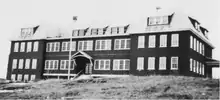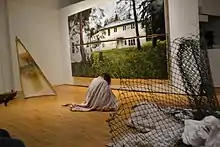Pelican Lake Indian Residential School
The Pelican Lake Indian Residential School, also known as Pelican Falls Indian Residential School,[1][2][3] or Sioux Lookout Indian Residential School,[4] was a Canadian Indian Residential School that operated from 1929 through 1969. While it was in operation the school took Ojibway and Cree[5] students from both Treaty Three and Treaty Nine territories in northern Ontario and eastern Manitoba.[6] Former students of the school have reported experiencing physical, psychological, and sexual abuse while attending the school.
History

Also known as Sioux Lookout Indian Residential School,[4] Pelican Lake Indian Residential School was established in 1926 and officially opened in 1929.[7] The school was one of the approximately three dozen schools operated by the Anglican Church of Canada.[8] It was the state-enforced Indian Residential School for Ojibway and Cree[5] students from both Treaty Three and Treaty Nine territories in northern Ontario and eastern Manitoba.[6] When it initially opened it housed a total of 125 students, both boys and girls; this number increased to 150 by the late 1940s.[9] Like most residential schools, the school was designed in a way that the male and female students had limited interaction with each other. Usually, students were removed from their families and brought to the school when they were six years old and stayed until they were twelve.[10]
When the school first opened, students spent a half-day in the classroom, and a half-day doing general labor. This labor was gendered, with young boys doing physical labour such as carpentry, and the girls doing more domestic tasks such as laundry and cooking.[11] In 1947 the school transitioned to a full-day school system.[12] As documented by the Church itself, the conditions of the school were poor. In 1946 the General Synod of the Anglican Church of Canada set up an Indian Work Investigation Commission to review and raise the standards in its schools.[13] After a three-year investigation it was recommended that Pelican Lake be closed as it was deemed substandard. The Anglican Bishop at the time successfully lobbied to keep the school in operation.[14]
Pelican Lake Residential School closed in 1969.[15]
Abuse and lawsuit
Many former students of Pelican Lake describe experiencing physical, psychological and sexual abuse while at the school. Physical abuse came in many different forms including poor living conditions, and corporal punishments for speaking a traditional language. Rather than attending class, some students were required to spend the day working.[6] Psychological abuse began with the act of taking the students who were small children away from their families. This abuse continued within the school and included actions such as public humiliation for bed wetting.[16] Many residential school survivors also were the victims of sexual abuse in various forms. Over a dozen students from Pelican Lake have come forward stating they were sexually assaulted while attending the school.[17]
The lasting impacts of residential schools also includes the heightened rate of disability amongst Indigenous peoples compared to non-Indigenous peoples.[18] Abuse suffered in residential schools continues to impact the mental health of Indigenous communities.[19] Indigenous peoples also experience a higher rate of disability due to heightened "rates of injury, accident, violence, self-destructive or suicidal behaviour and illness".[20] These are a result of the negative health impacts of residential schools for the survivors and the subsequent generations in the family.[21]
In 1996 Leonard Hands, an Anglican priest who worked at the school during the 1960s was charged with 19 counts of indecent assault. He entered a guilty plea and was sentenced to four years in prison.[22] The case was initiated by Garnet Angeconeb[23] who was one of the first individuals to begin publicly discussing the abuse they had suffered at the school. Hands remains the only individual who has been held criminally responsible for their role in the Pelican Lake Residential School.[24]
Physical education
Until World War II many residential schools employed very regimented exercise with limited team sports.[16] In the 1950s, there was an increase in the role of sports teams at many residential schools, as government policy surrounding the goals of residential schools themselves changed. Rather than trying to eliminate Indigenous peoples, the school's goal was to push Indigenous individuals to integrate into society.[6] Hockey was seen as a way to assert more control over the pupils. Named the Sioux Black Hawks, the team of all boys started with no experience skating.[6] The team was initiated by Gifford Swartman, superintendent of the town's Indian agency, and telephone company owner Art Schade. The students were provided equipment with assistance from local businesses and an outdoor rink was built to help them prepare for play against Sioux and District Bantam league.[25] After a couple years of playing against neighboring Indigenous and non-Indigenous the team improved, and began winning competitions.
In the spring of 1951 the Department of Indian Affairs paid for the team to go on a tour of southern Ontario. Although the Department of Indian Affairs stated there were not enough funds to adequately improve the conditions of the school,[13] the team travelled to Ottawa and Toronto. The team and the trip were publicized and was used by administrators as a way to promote the school.[26] The travelling team consisted of ten Ojibway and three Cree students, including Albert Carpenter, Ernie Wesley and Jerry Ross. Swartman, Sioux Lookout mayor Bill Fuller, and residential school teacher Bruce McCully, serving as team coach, accompanied the students on the tour. During the trip the team met with the Premier of Ontario and the Governor General of Canada.[25]
Pelican Lake since the school's closure
In 1978, the Pelican Lake Residential School was torn down. Today in its place sits the Pelican Falls First Nations High School and Centre (PFFNHS).[27]

PFFNHS accepts students from 24 First Nation Communities and is controlled by local First Nations.[28]
In 2004, the "Pelican Residential School Monument and Memorial Garden" was opened.[2] The monument was funded by both the Aboriginal Healing Fund, and the Department of Indian and Northern Affairs Canada.[1] The opening took place at the Pelican Residential School Monument and Memorial Garden Opening and Healing Conference. The conference was a three day event that included many events such as: keynotes addresses, workshops, and a pow wow.[29]
Artists such as Lara Kramer have drawn upon her family's experience at Pelican Lake Residential School as inspiration for public works of art. Kramer's performance installation, "Phantom, stills and vibrations" was shown at Artspace in Peterborough in March 2018.[30][31] The performance installation used still images from Pelican Lake Residential School, objects that evoked memories of the school which also memorialized the children who attended the school, audio of her family's experiences and of sounds of the land, and included a dance performance.[32]
References
- Our Daily Fry Bread (October 3, 2004). "Memorial Honours Former Residential School Students". inJesus. Retrieved April 5, 2018.
- Brody, Tim. "Weekend at Pelican Falls part of a healing journey" (PDF). The Sioux Lookout Bulletin. Retrieved April 5, 2018.
- Union of Ontario Indians, An Overview of the Indian Residential School System. 2013. http://www.anishinabek.ca/wp-content/uploads/2016/07/An-Overview-of-the-IRS-System-Booklet.pdf
- Te Hiwi, Braden, and Janice Forsyth. "'A Rink at this School is Almost as Essential as a Classroom': Hockey and Discipline at Pelican Lake Indian Residential School, 1945–1951". Canadian Journal of History 52.1 (2017): 89.
- "Historical Sketch for Anglican Residential Schools"....
- Te Hiwi, Braden, and Janice Forsyth. 85.
- Miller, Jim R. "Troubled legacy: A history of Native residential schools". Saskatchewan Law Review 66 (2003): 357.
- "Historical Sketch for Anglican Residential Schools". Truth and Reconciliation, Anglican Church of Canada, 2017, https://www.anglican.ca/tr/schools/.
- Te Hiwi, Braden, and Janice Forsyth. 83.
- Angeconeb, Garnet. "Speaking my truth: The journey to reconciliation". Speaking my truth: Reflections on reconciliation & residential school (2012): 11-36.
- Miller, Jim R. 369.
- Te Hiwi, Braden, and Janice Forsyth. 88.
- Te Hiwi, Braden, and Janice Forsyth. 91.
- Te Hiwi, Braden, and Janice Forsyth. 93.
- Miller, Jim R. 357.
- Te Hiwi, Braden, and Janice Forsyth. 84.
- Angeconeb, Garnet. 23.
- Durst, D. & Coburn. E. "Who is Ready to Listen: Aboriginal People with Disabilities". Chapter 3, In E. Ciburn. (Ed.) More will sing their way to freedom: Indigenous Resistance and Resurgence. Halifax NS: Fernwood Press. (2015): 97.
- Durst, D. "Indigenous People with Disabilities: Stories of Resiliency and Strength" Chapter 9. In J. Robertson & G. Larson. (Eds.). Disability and Social Change: A Progressive Canadian Approach. Halifax, NS: Fernwood Press. (2016): 169.
- Durst, D. & Coburn. E. 98.
- Wilk, Piotr, Alana Maltby, and Martin Cooke. "Residential schools and the effects on Indigenous health and well-being in Canada—a scoping review." Public Health Reviews 38.1 (2017): 8.
- Angeconeb, Garnet. 29.
- Garnet Angeconeb
- Shea, Goldie. "Institutional Child Abuse in Canada: Criminal Cases". Law Commission of Canada. (1999).
- Campbell, Gordon (17 April 1951). "'Better than five years in school' coach says of Indian lads' tour". Toronto Star. p. 19.
- Te Hiwi, Braden, and Janice Forsyth. 97.
- "Chapter Two: Residential School". Garnet's Journey, Garnet Angeconeb and Ashley Wright, 26 Aug. 2012, https://www.garnetsjourney.com/chapters/residential-school/.
- "Pelican Falls First Nations High School". Northern Nishnawbe Education Council, Northern Nishnawbe Education Council, 2017, http://www.nnec.on.ca/index.php/pelican-falls-first-nations-high-school/.
- "Pelican Residential School Monument and Memorial Garden Opening and Conference". Media Knet. September 1, 2004. Retrieved April 3, 2018.
- Artspace
- "Lara Kramer; 2017-2018 Ashley Fellow". Trent University. February 2018. Retrieved April 5, 2018.
- Anderson, Lance (February 23, 2018). "Lara Kramer to perform Phantom, stills & vibrations during her Trent artist residency". myKawartha. Retrieved April 5, 2018.